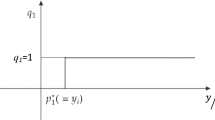Abstract
Over the recent four decades, agent-based modeling and maximum entropy modeling have provided some of the most notable contributions applying concepts from complexity science to a broad range of problems in economics. In this paper, we argue that these two seemingly unrelated approaches can actually complement each other, providing a powerful conceptual/empirical tool for the analysis of complex economic problems. The maximum entropy approach is particularly well suited for an analytically rigorous study of the qualitative properties of systems in quasi-equilibrium. Agent-based modeling, unconstrained by either equilibrium or analytical tractability considerations, can provide a richer picture of the system under study by allowing for a wider choice of behavioral assumptions. In order to demonstrate the complementarity of these approaches, we use here two simple economic models based on maximum entropy principles – a quantal response social interaction model and a market feedback model –, for which we develop agent-based equivalent models. On the one hand, this allows us to highlight the potential of maximum entropy models for guiding the development of well-grounded, first-approximation agent-based models. On the other hand, we are also able to demonstrate the capabilities of agent-based models for tracking irreversible and out-of-equilibrium dynamics as well as for exploring the consequences of agent heterogeneity, thus fundamentally improving on the original maximum entropy model and potentially guiding its further extension.
Article PDF
Similar content being viewed by others
Avoid common mistakes on your manuscript.
References
C.A. Sims, J. Monetary Econ. 50, 665 (2003)
C.A. Sims, Rational inattention: A research agenda (2006), http://sims.princeton.edu/yftp/RIplus/RatInattPlus.pdf
R. Baptista, J.D. Farmer, M. Hinterschweiger, K. Low, D. Tang, A. Uluc, Macroprudential Policy in an Agent-based Model of the UK Housing Market (2016), DOI: https://doi.org/10.2139/ssrn.2850414
D.K. Foley, Information theory and behavior, Working Papers 1731, New School for Social Research, Department of Economics, 2017
E. Scharfenaker, D.K. Foley, Entropy 19, 444 (2017)
C. Shannon, Bell Syst. Tech. J. 27, 379 (1948)
E.T. Jaynes, Probability Theory: The Logic of Science (Cambridge University Press, 2003)
T.M. Cover, J.A. Thomas, Elements of Information Theory, 2nd edn. (Wiley-Interscience, 2006)
D.J. MacKay, Information Theory, Inference, and Learning Algorithms (Cambridge University Press, 2005)
F.A. Bais, J.D. Farmer, The physics of information, https://arXiv:0708.2837 (2007)
J. Yang, J. Econ. Surv. 32, 940 (2018)
H. Theil, Economics and Information Theory (North-Holland, Amsterdam, 1970)
E. Scharfenaker, G. Semieniuk, Metroeconomica 68, 465 (2017)
A. Irle, M. Milakovic, S. Alfarano, J. Kauschke, J. Econ. Dyn. Control 36, 136 (2012)
E. Scharfenaker, P.L. dos Santos, Econ. Lett. 137, 191 (2015)
D.H. Wolpert, Information Theory – The Bridge Connecting Bounded Rational Game Theory and Statistical Physics, in Complex Engineered Systems (Springer, Berlin, Heidelberg, 2006), pp. 262–290
J. von Neumann, O. Morgenstern, Theory of Games and Economic Behavior (Princeton University Press, 1944)
A. Anas, Transp. Res. Part B: Methodol. 17, 13 (1983)
K. Blackwell, Entropy constrained behavior in financial markets: A quantal response statistical equilibrium approach to financial modeling, Ph.D. diss., The New School, 2018
J.M. Borwein, A.S. Lewis, Trans. Am. Math. Soc. 325, 249 (1991)
S. Boyd, L. Vandenberghe, Convex Optimization (Cambridge University Press, 2004)
R.D. McKelvey, T.R. Palfrey, Quantal response equilibria for normal form games (1996)
R.D. Mckelvey, T.R. Palfrey, Experimental Economics 1, 9 (1998)
T. Lux, M. Marchesi, Nature 397, 498 (1999)
T. Kaizoji, Physica A 287, 493 (2000)
S. Bornholdt, Int. J. Mod. Phys. C 12, 667 (2001)
R. Axtell, Why agents? On the varied motivations for agent computing in the social sciences, The Brookings Institution Center on Social and Economic Dynamics Working Paper, Nov 17, 2000
D. Cherkashin, J.D. Farmer, S. Lloyd, J. Econ. Dyn. Control 33, 1091 (2009)
Z. Xu, G. Bi, D. Zhou, D. Cai, Commun. Math. Sci. 15 (2017) 665
M. Castellana, W. Bialek, Phys. Rev. Lett. 113, 117204 (2014)
J. Sakellariou, F. Tria, V. Loreto, F. Pachet, Sci. Rep. 7, 9172 (2017)
J.L. Lebowitz, H. Saleur, Physica A 138, 194 (1986)
A. Kirman, Q. J. Econ. 108, 137 (1993)
B.L. Granovsky, N. Madras, Stoc. Proc. Appl. 55, 23 (1995)
S. Alfarano, T. Lux, F. Wagner, J. Econ. Dyn. Control 32, 101 (2008)
A. Carro, R. Toral, M. San Miguel, PloS One 10, e0133287 (2015)
M. Diakonova, V.M. Eguluz, M. San Miguel, Phys. Rev. E 92, 032803 (2015)
L. Rozanova, M. Boguñá, Phys. Rev. E 96, 012310 (2017)
A. Carro, R. Toral, M. San Miguel, Sci. Rep. 6, 24775 (2016)
A.F. Peralta, A. Carro, M. San Miguel, R. Toral, New J. Phys. 20, 103045 (2018)
O. Artime, A. Carro, A.F. Peralta, J.J. Ramasco, M. San Miguel, R. Toral, C. R. Phys. 20, 262 (2019)
Author information
Authors and Affiliations
Corresponding author
Additional information
Publisher’s Note
The EPJ Publishers remain neutral with regard to jurisdictional claims in published maps and institutional affiliations.
Rights and permissions
Open Access This is an Open Access article distributed under the terms of the Creative Commons Attribution License (https://creativecommons.org/licenses/by/4.0), which permits unrestricted use, distribution, and reproduction in any medium, provided the original work is properly cited.
About this article
Cite this article
Yang, J., Carro, A. Two tales of complex system analysis: MaxEnt and agent-based modeling. Eur. Phys. J. Spec. Top. 229, 1623–1643 (2020). https://doi.org/10.1140/epjst/e2020-900137-x
Received:
Revised:
Published:
Issue Date:
DOI: https://doi.org/10.1140/epjst/e2020-900137-x




